Zhenbo Li
TEn-CATS: Text-Enriched Audio-Visual Video Parsing with Multi-Scale Category-Aware Temporal Graph
Sep 04, 2025Abstract:Audio-Visual Video Parsing (AVVP) task aims to identify event categories and their occurrence times in a given video with weakly supervised labels. Existing methods typically fall into two categories: (i) designing enhanced architectures based on attention mechanism for better temporal modeling, and (ii) generating richer pseudo-labels to compensate for the absence of frame-level annotations. However, the first type methods treat noisy segment-level pseudo labels as reliable supervision and the second type methods let indiscriminate attention spread them across all frames, the initial errors are repeatedly amplified during training. To address this issue, we propose a method that combines the Bi-Directional Text Fusion (BiT) module and Category-Aware Temporal Graph (CATS) module. Specifically, we integrate the strengths and complementarity of the two previous research directions. We first perform semantic injection and dynamic calibration on audio and visual modality features through the BiT module, to locate and purify cleaner and richer semantic cues. Then, we leverage the CATS module for semantic propagation and connection to enable precise semantic information dissemination across time. Experimental results demonstrate that our proposed method achieves state-of-the-art (SOTA) performance in multiple key indicators on two benchmark datasets, LLP and UnAV-100.
When Trackers Date Fish: A Benchmark and Framework for Underwater Multiple Fish Tracking
Jul 08, 2025Abstract:Multiple object tracking (MOT) technology has made significant progress in terrestrial applications, but underwater tracking scenarios remain underexplored despite their importance to marine ecology and aquaculture. We present Multiple Fish Tracking Dataset 2025 (MFT25), the first comprehensive dataset specifically designed for underwater multiple fish tracking, featuring 15 diverse video sequences with 408,578 meticulously annotated bounding boxes across 48,066 frames. Our dataset captures various underwater environments, fish species, and challenging conditions including occlusions, similar appearances, and erratic motion patterns. Additionally, we introduce Scale-aware and Unscented Tracker (SU-T), a specialized tracking framework featuring an Unscented Kalman Filter (UKF) optimized for non-linear fish swimming patterns and a novel Fish-Intersection-over-Union (FishIoU) matching that accounts for the unique morphological characteristics of aquatic species. Extensive experiments demonstrate that our SU-T baseline achieves state-of-the-art performance on MFT25, with 34.1 HOTA and 44.6 IDF1, while revealing fundamental differences between fish tracking and terrestrial object tracking scenarios. MFT25 establishes a robust foundation for advancing research in underwater tracking systems with important applications in marine biology, aquaculture monitoring, and ecological conservation. The dataset and codes are released at https://vranlee.github.io/SU-T/.
CM-PIE: Cross-modal perception for interactive-enhanced audio-visual video parsing
Oct 11, 2023Abstract:Audio-visual video parsing is the task of categorizing a video at the segment level with weak labels, and predicting them as audible or visible events. Recent methods for this task leverage the attention mechanism to capture the semantic correlations among the whole video across the audio-visual modalities. However, these approaches have overlooked the importance of individual segments within a video and the relationship among them, and tend to rely on a single modality when learning features. In this paper, we propose a novel interactive-enhanced cross-modal perception method~(CM-PIE), which can learn fine-grained features by applying a segment-based attention module. Furthermore, a cross-modal aggregation block is introduced to jointly optimize the semantic representation of audio and visual signals by enhancing inter-modal interactions. The experimental results show that our model offers improved parsing performance on the Look, Listen, and Parse dataset compared to other methods.
A Review of Computer Vision Technologies for Fish Tracking
Oct 11, 2021


Abstract:Fish tracking based on computer vision is a complex and challenging task in fishery production and ecological studies. Most of the applications of fish tracking use classic filtering algorithms, which lack in accuracy and efficiency. To solve this issue, deep learning methods utilized deep neural networks to extract the features, which achieve a good performance in the fish tracking. Some one-stage detection algorithms have gradually been adopted in this area for the real-time applications. The transfer learning to fish target is the current development direction. At present, fish tracking technology is not enough to cover actual application requirements. According to the literature data collected by us, there has not been any extensive review about vision-based fish tracking in the community. In this paper, we introduced the development and application prospects of fish tracking technology in last ten years. Firstly, we introduced the open source datasets of fish, and summarized the preprocessing technologies of underwater images. Secondly, we analyzed the detection and tracking algorithms for fish, and sorted out some transferable frontier tracking model. Thirdly, we listed the actual applications, metrics and bottlenecks of the fish tracking such as occlusion and multi-scale. Finally, we give the discussion for fish tracking datasets, solutions of the bottlenecks, and improvements. We expect that our work can help the fish tracking models to achieve higher accuracy and robustness.
SOTR: Segmenting Objects with Transformers
Aug 17, 2021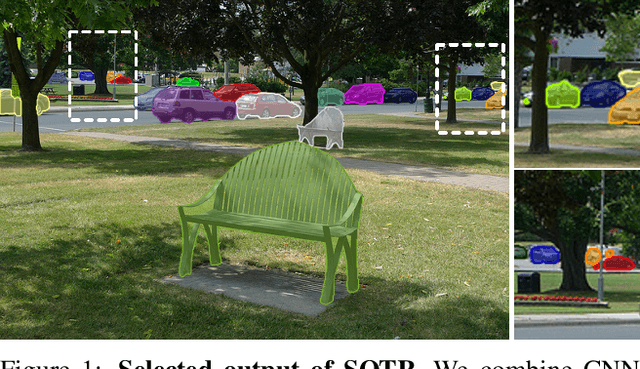

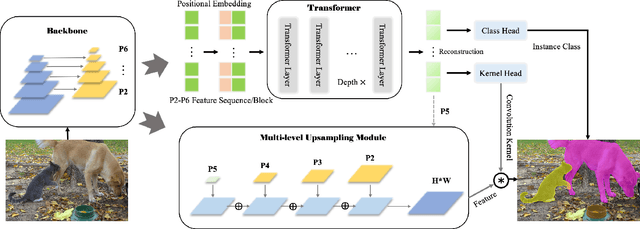

Abstract:Most recent transformer-based models show impressive performance on vision tasks, even better than Convolution Neural Networks (CNN). In this work, we present a novel, flexible, and effective transformer-based model for high-quality instance segmentation. The proposed method, Segmenting Objects with TRansformers (SOTR), simplifies the segmentation pipeline, building on an alternative CNN backbone appended with two parallel subtasks: (1) predicting per-instance category via transformer and (2) dynamically generating segmentation mask with the multi-level upsampling module. SOTR can effectively extract lower-level feature representations and capture long-range context dependencies by Feature Pyramid Network (FPN) and twin transformer, respectively. Meanwhile, compared with the original transformer, the proposed twin transformer is time- and resource-efficient since only a row and a column attention are involved to encode pixels. Moreover, SOTR is easy to be incorporated with various CNN backbones and transformer model variants to make considerable improvements for the segmentation accuracy and training convergence. Extensive experiments show that our SOTR performs well on the MS COCO dataset and surpasses state-of-the-art instance segmentation approaches. We hope our simple but strong framework could serve as a preferment baseline for instance-level recognition. Our code is available at https://github.com/easton-cau/SOTR.
LeafMask: Towards Greater Accuracy on Leaf Segmentation
Aug 08, 2021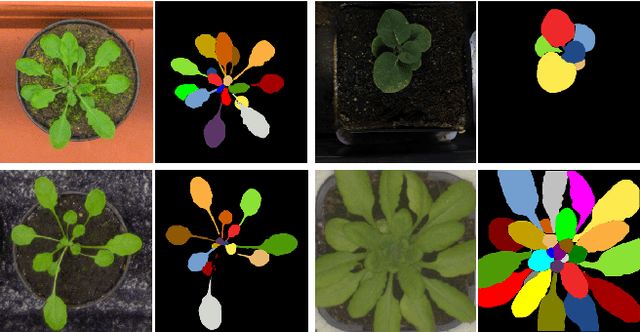
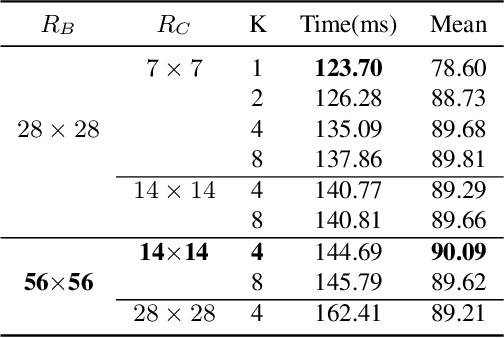
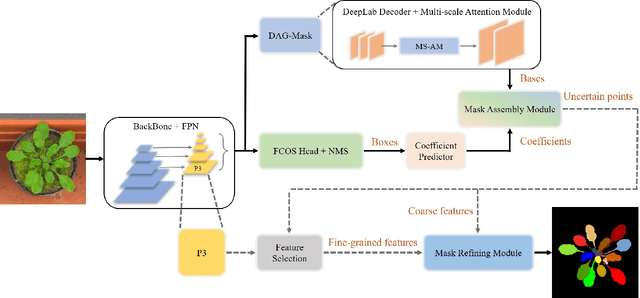
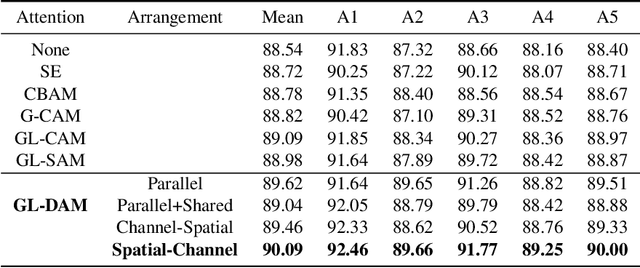
Abstract:Leaf segmentation is the most direct and effective way for high-throughput plant phenotype data analysis and quantitative researches of complex traits. Currently, the primary goal of plant phenotyping is to raise the accuracy of the autonomous phenotypic measurement. In this work, we present the LeafMask neural network, a new end-to-end model to delineate each leaf region and count the number of leaves, with two main components: 1) the mask assembly module merging position-sensitive bases of each predicted box after non-maximum suppression (NMS) and corresponding coefficients to generate original masks; 2) the mask refining module elaborating leaf boundaries from the mask assembly module by the point selection strategy and predictor. In addition, we also design a novel and flexible multi-scale attention module for the dual attention-guided mask (DAG-Mask) branch to effectively enhance information expression and produce more accurate bases. Our main contribution is to generate the final improved masks by combining the mask assembly module with the mask refining module under the anchor-free instance segmentation paradigm. We validate our LeafMask through extensive experiments on Leaf Segmentation Challenge (LSC) dataset. Our proposed model achieves the 90.09% BestDice score outperforming other state-of-the-art approaches.
 Add to Chrome
Add to Chrome Add to Firefox
Add to Firefox Add to Edge
Add to Edge